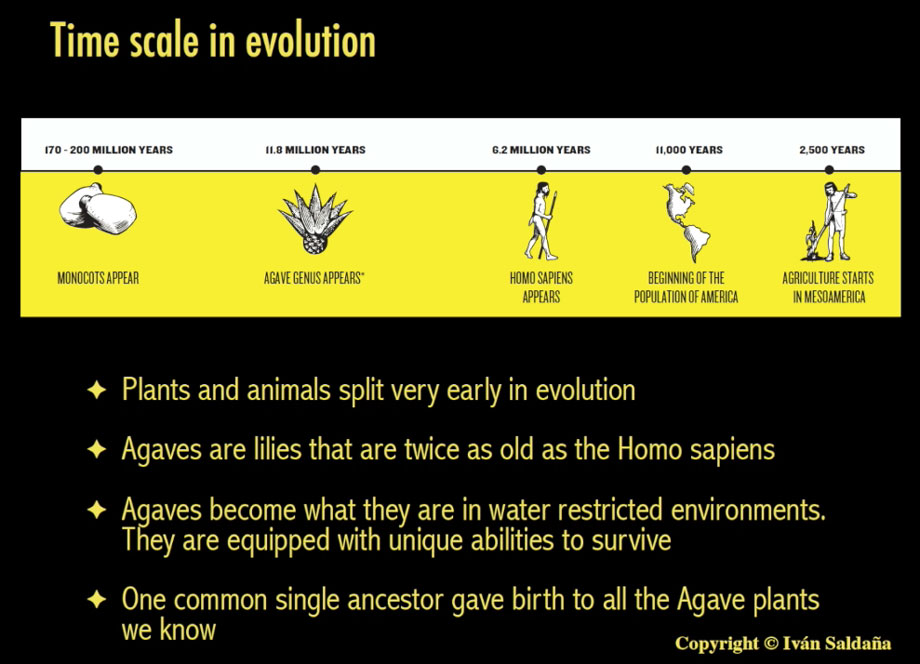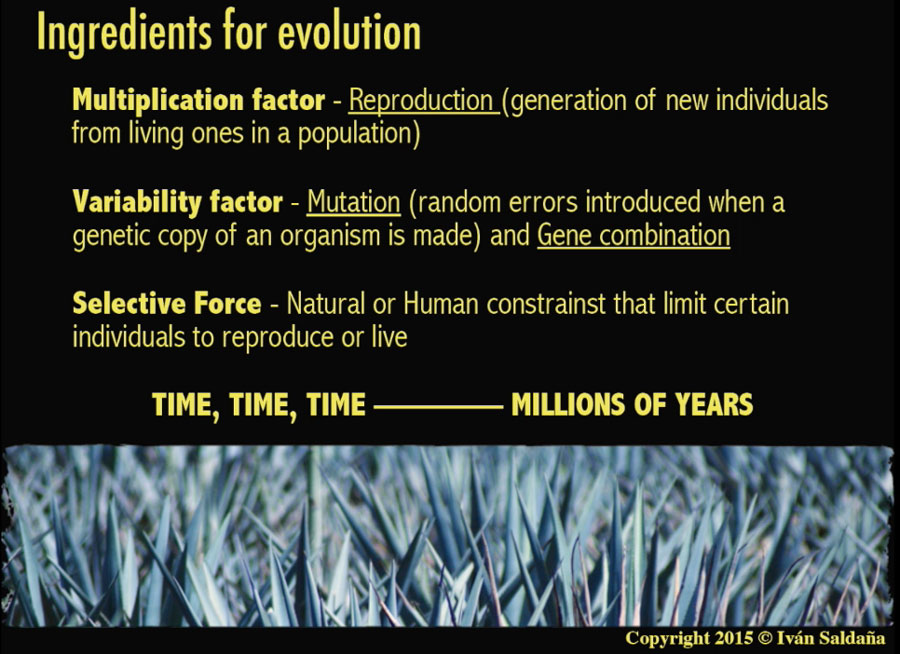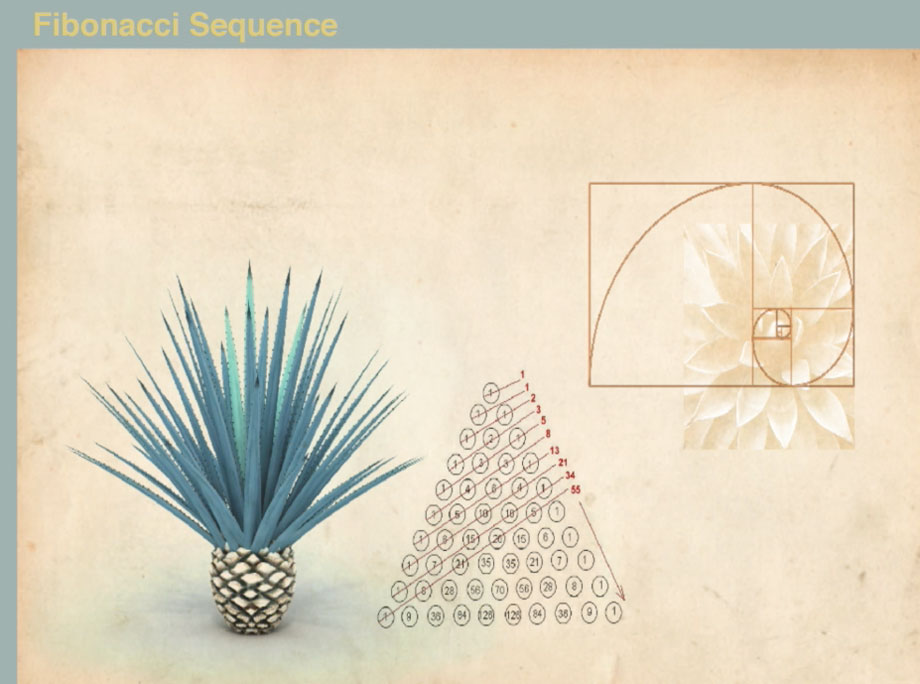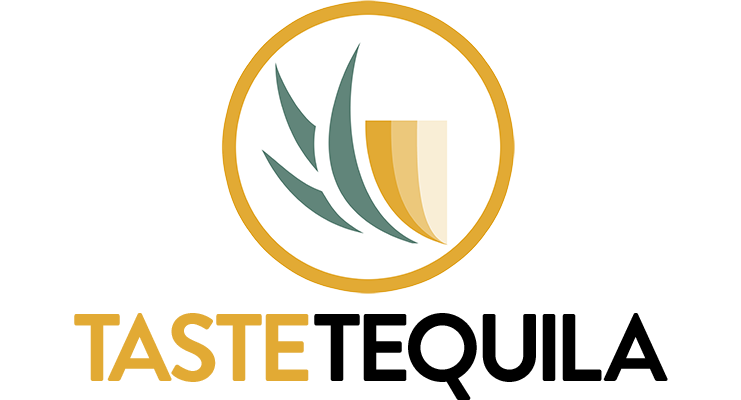Agave isn’t just another plant. This one is special.
 We never realized just how incredible it was until we attended a presentation by Dr. Ivan Saldaña Oyarzábal, earned a Ph.D. in Plant Biology/Biochemistry from the University of Sussex, in Great Britain, and is co-founder of Montelobos Mezcal. It was held at the Tequila Lounge inside of the Mexhibit Grupo Expositor in Guadalajara, coordinated by Tomas Estes, of Tequila Ocho, and captured on video by us.
We never realized just how incredible it was until we attended a presentation by Dr. Ivan Saldaña Oyarzábal, earned a Ph.D. in Plant Biology/Biochemistry from the University of Sussex, in Great Britain, and is co-founder of Montelobos Mezcal. It was held at the Tequila Lounge inside of the Mexhibit Grupo Expositor in Guadalajara, coordinated by Tomas Estes, of Tequila Ocho, and captured on video by us.
Folks, Tequila School is now in session.
Saldaña’s presentation (and this video) is densely packed with a ton of information. To make things easier, we’ve transcribed the portions that we found to be the most interesting (below), included the time stamp, and added some comments of our own.
What did you find interesting? Please let us know in the comments below.

04:20
Topic: The importance of raw materials in the production of spirits.
04:54 – 05:35
“Although most spirits talk mostly about how they flavor the spirit once it is made, like whisky, the general goal tends to be the creation of a constant and consistant product. They are more concerned with how you flavor the product, using oak barrels, or, in the case of gin, the botanicals they add.”
- TT: Maintaining a consistent product is considered to be critical by most brands. However, the products that are different from batch-to-batch are also the ones that are more honest. There is less of a need for additives, and more acceptance of the natural process at work. Brands that embrace these differences should be commended, encouraged, and respected.
05:53
“I think that agave has a unique story. Not only because of what it is as a plant, but also about the land it’s coming from and the properties and qualities that can be obtained depending on how we treat that agave through the agricultural process.”
- TT: This is an interesting thing to consider. The experiences that each individual agave plant has had in its lifetime will ultimately affect the finished product.
06:15
“Alcohol is typically made from grains and fruits. When we talk about grains we typically get quite a boring source when compared to agave, of course, of flavors. Grains offer a great amount of starch that we can hydrolyze and break down into simple sugars, mostly glucose, so then yeast can feed on it and produce all sorts of things. In fermentation, yeast can produce flavorful molecules, but in the case of grains, it’s really only the yeast that, most of the time, is bringing us some sort of flavor. Because there’s not much chemical complexity there.”
06:55
“When we look at fruits, we look a little bit above that. Suddenly you have organic acids, you have some terpenes, which are things that are very smelly, like flowers have a lot of terpenes for example, and you have other sugars that are simple to digest. Sucrose, fructose, glucose, things that are sweet already. And from them you can get interesting spirits from grapes, from apples. Technically you can use all sorts of other fruits. I think there is a lot of potential in the future to look at other fruits, like pineapples, for example, and making alcohol out of them that offers complexity.”
07:35
“Nothing is like the agave plant, which is really like a gigantic herb that can simultaneously produce sugars (a weird type of sugars, but sugars) and at the same time offer qualities that herbs most typically offer.”
07:51
“Let’s say, there’s a gin-like dimension, I’m referring to the herbaceous dimensions of plants that are typically added to sugars. But when we make mezcal or tequila it is like making a gin in a single step. We trap all of these flavors from the herb itself while at the same time making the alcohol that can be produced through the transformation of sugars into ethanol.”
08:22
 “The chemical complexity of the agave is out of this world when compared to the other group of plants. Why? Well, agaves, with such a long life span … from 6, up to 35 years, they have to fight for survival. This is a biological example of resistance. The common ancestor of all agaves evolved in very harsh conditions in the middle of the desert, so a lot of this chemistry you are able to trap in tequila and mezcal, is really chemical weapons in order to fight back against predators. From big mammals who want to eat them, to bacteria or fungi/yeast that also wants to benefit from the great amount of sugar and water that an agave is able to hold in the midst of scarcity.”
“The chemical complexity of the agave is out of this world when compared to the other group of plants. Why? Well, agaves, with such a long life span … from 6, up to 35 years, they have to fight for survival. This is a biological example of resistance. The common ancestor of all agaves evolved in very harsh conditions in the middle of the desert, so a lot of this chemistry you are able to trap in tequila and mezcal, is really chemical weapons in order to fight back against predators. From big mammals who want to eat them, to bacteria or fungi/yeast that also wants to benefit from the great amount of sugar and water that an agave is able to hold in the midst of scarcity.”
09:44
“I believe, of course, in the art of the distiller, but the reason tequila and mezcal are so incredibly attractive, is because of the raw material. If we really think our business is only in making alcohol out of agave, we are losing a great opportunity to indulge ourselves and others, trapping a much more delicate and interesting story while we taste what we do in our brand’s products. So I really think that we have to look back into the agave and start to think how creatively we can bring wonderful things to others.”
17:30
“There are entire quality control departments in tequila companies… that really reduce quality in favor of consistency. They are not really pushing themselves to bring the most and the best product they can actually offer because the product is always the same.”
- TT: Another interesting point. Although “quality control” sounds important, it also strips experimentation, variation, and most of the natural gifts that agave wants to give to us.

22:52
“The standardization of raw material: So, processes, they really want to simplify receiving certain raw material and bringing something out, and then they do the flavoring afterwards. So, we have learned now we have big flavoring houses, we have companies that can give you all sort of different oak extracts, for example, for those that age… There’s companies who have extracted agave flavors, vanillin, for example, a very abundant compound in blue agave. You can buy it and add it. And we know a lot of the people are controlling a lot of the product at the end of it. And, legislation has changed and evolved through time to allow these types of things. I’m not saying everything is terrible, I just want to say that I think we are in a moment that other types of expressions can come out and surprise us.”
- So “quality control” is more about consistency and a dependence on additives and coloring to maintain it. It’s a shame that additives have taken over such a large portion of the tequila world. Is the consumer demanding a strict adherence to consistency, or is there a place for slight variations created in the natural process?

25:04
“Agaves are monocots. Monocots, the first ancestors appeared 200 million years ago. Agave, an American plant, appeared 12 million years ago.”
“And it’s only 11,000 years that we [humans] met in this continent, and 2,500 years ago we started to plant and to grow agaves here.”

26:09
“What I think is important is the fact that agaves are grouped together in a group of plants. They are closely related more than what you think, like a gorilla and a man, with onion, garlic, pineapple, asparagus, nenufars [lilies], palm trees, have a lot in common. When you look at the genes, their morphology, thinking about these semi-circular things with leaves coming from the center, they share all of that. Some, maybe the leaves are underground like in an onion, or giving a shadow like in a palm tree, but they share variation biology.”
26:47
“And they are SO far away from nopal. It’s like saying birds and butterflies are closely related. Yes, both have wings and yes, both can fly, but they are really far away in the story of biology. The same with cactus.”
- TT: OMG, yes! Agave is not a cactus!
27:03
“There [are] around 200 to 150 species of agave, and I’m going to show you some examples. It’s very arbitrary, what is really a species and what is not, and how much time we should be putting effort to identify that. Or for what reasons we are looking at those differentiations.”
27:20
“Most of the agaves are in Mexico, I think most of you know. We have, of course, some mezcal in Venezuela called ‘cocuy’ that they produce in really small amounts: it’s probably one of the southern most that are utilized for spirits in Venezuela. We also have some agave in the south of the United States, and Oaxaca, and then Jalisco, and then Michoacan. [They] are the most biodiverse states with the agaves.”
27:45
“But we also have lots of agave right now as humans, not as Mexicans, because that doesn’t belong to us anymore. In Australia, India, Africa, in the Mediterranean, it’s a weed.”

28:05
“Ingredients for evolution: 3 things. You have a multiplication factor, so you are able to create new individuals. A viability factor, that is a mixture of things. One is gene combinations of different populations that are close by, or families, let’s say. And an element that is random called mutation.”
“So, every now and then our genes change randomly, we change information and suddenly that could have some sense, and brings us to a new place. So when you do a lot of different individuals that are genetically different you create choices. Difference, opportunities, when the selective force arrives.”
“That’s the third ingredient, something that will press a population, will kill, or will [incapacitate] some to reproduce, and you will have a fewer number of individuals that will get multiplied again and then will have viability and then will be selected again, and when you repeat that millions of times you finish with a different variety.”
“That’s why Oaxaca has so much diversity, because it’s one of the most accidental geographies in this country. Jalisco also has an incredible accidental conditions and different weathers and altitudes because you get isolation and you let selective forces to work in particular areas and that’s when some day one plant cannot cross to another plant so they can not be called the same species anymore.”
- TT: If you needed to stop, rewind, and watch that again several times, you’re not alone. There’s a lot of information packed in there. This explains why there are so many different types of agave in the world, and how each one contributes their own aroma and flavor characteristics when used to create spirits.
29:38
“In the viability part you have a very important element that is how you reproduce, how you create new individuals. You can do this sexually or asexually. A long time ago, and still today, it’s hard but it can be done. Blue Agave had a good amount of sexual reproduction, and it was possible. Right now it’s getting more rare, more complicated to get viable seeds, so it’s mostly asexual. But you have other species like Agave Potatorum, that is Tobala or Cupreata, the requires, really, I mean they don’t have the tools to asexually reproduce.”
30:16
“The decision of going sexual or asexual is really a very clever mechanism [for] making decisions. If conditions are great, these agaves that can use both, like Espadin, for instance, that do both things. It may spend more of its sugars creating little plants around. But if conditions are harsh, it’s rather more intelligent to probably reduce the amount of multiplications of new plants in order to make the tallest, biggest flower that it can actually make in order to take its genes away.”
“So it’s interesting how stress sometimes promotes the accumulation of sugars for flowering, and in very nice conditions promotes spending like crazy of the plant with no winning sugar, which is something we are quite interested in the business of making spirits.”
- TT: How amazing is that? The plant is making decisions based on the stresses (or lack thereof) it is experiencing. Mind blown.
31:08
“There are all sorts of selective forces, but for sure, humans, right now, are the strongest. Through evolution the agave had to find solutions to physical stress, like the succulence (the ability to capture water), cuticle (all the waxes you find in the surface, so in the very hot days our plants do not dehydrate), and other chemical, nasty solutions to keeping away all sorts of bacteria and insects (which are typically saponenes), or the oxylates (which are these crystals that scratch you, when the workers, the jimadores, are taking the leaves out, they get harmed.)”
31:53
“Some of the adaptations that are unique, and that makes agave such a different plant: The succulence of water storage, the root systems (you’re going to see some photos later on), they can grow in hours if you have very harsh conditions and some rains come down they start to invest and they produce secondary roots to absorb the water as fast as they can because many of these agaves live in very porous soils that let water go away.”
32:21
“Nocturnal CO2 fixation, so they control when to open this little window. They do it at night when conditions are fresher and during the day when there is heat, they use the waxes to close themselves as not to lose water.”
“Storage of the specialized sugars, fructans, a very clever solution to herbivores. If you try to eat raw agave you die of diarrhea a couple of days after. Then we later on learned that if we roast those agaves we not only make sugars but caramels. That’s another thing why it tastes so good, all these spirits, because we produce a lot of flavorful molecules when we burn those sugars.”
- TT: Don’t eat raw agave!!

33:00
“They have a rosette structure, very beautiful. They follow a febonacci sequence… they have very intelligent leaves, that maximize the surface for photosynthesis, they never shadow one against the other and everything is arranged that you have a cenital light in agave, each leave will have its maximum potential of absorbing light, which is quite outstanding. It’s concave, so it will bring the water, even though it’s a slight rain, immediately to the center of the plant where the root system is most concentrated, and it will be able to recharge its source of water.”
34:25
Microscopic view of agave plant: “That thing is a needle of oxalate is what makes you the dermatitis. We also have very wide, big, fatty, full of water cells that allow the storage of resources.”
35:10
“The root system. This is an experiment of putting fresh water to a drought-stressed blue agave and measuring how fast the roots start to grow in order to capture water as soon as they can.”
35:24
“Terpenes. Very interesting. Vanillin is within this group of molecules. We get it from the barrels, but we get it from the plant as well. There are studies on terpenes and you can reach up to 35 to 40 different terpenes in an agave plant.”
“The gin producers are looking for them. But they cheat. Well, they don’t “cheat”, but they go and they get many plants and they put it in alcohol and then they distill it again. We have the luxury of being able to get it [from one plant].”
“All of the proportions of these things, and its synthesis is based on the environmental conditions in which the plants grow. So, you will not get exactly the same proportion of terpenes from agaves growing in certain conditions than in others.”
“If you have a massive production process, and if you are not taking care of when the terpenes come out, (that is typically very early in the distillation) [you lose aromas]. People don’t like heads but sometimes it’s hard… but you need to go really slowly to first get the terpenes and then get those first liters… but immediately after what we would call heads, you will lose them, or lose some of them.”
“So, people need to understand what they have in the raw material because we actually have a lot of things.”
- TT: This explains why cutting the heads and tails is such an important step in the process. Do it incorrectly and you end up with a more neutral end product.
36:50
“If, and only if, water is scarce, the dependence of photosynthesis is based on how much water is present, agave are the most efficient water use plants on earth.”
37:42
Screen text: “Terpenes have a strong herbaceous smell. Some typical notes are mint, anise, pine tree, pepper, grass, citrus, vanilla, etc.”
37:56
Screen text: “Agaves use fat to keep their water in. Fat serve as barriers that reduce the evaporation of water. Climate can drastically modify the synthesis of fat in agave.”
38:21
“Fructans. You cannot digest them. The fact that you have to burn them creates what is called a Maillard reaction, which brings all these different compounds… All of them have flavors like nutty, roasted, green, bitter, astringent, burned, cracker-like, cereal-like.”
38:55
“So, it matters how we roast the sugars. It’s not only the efficiency of breaking them down, it’s really the longer it takes, the condition of the reaction, will produce the maximum, medium, minimum amount of different compounds. And the slower you do it, you generally get more diversity of this chemical richness.”
- TT: The slower you cook an agave, the more aromas and flavors it will release. This is the main reason why we tend to avoid any product made with industrial diffusers where the process is rushed. As a result, the lack of natural aromas and flavors then requires the use of additives to artificially bring them back.
47:06
“Terroir is much bigger than we think. We already know, and everybody who buys agave knows, that climatic conditions between the Tequila Valley and Los Altos are substantially different in terms of weather, precipitation, type of soils, of course, and that the resulting agave, and the density you can plant those agaves, is different as well.”
Thank you, Iván, for sharing your deep knowledge of our favorite plant on earth.


http://tastetequila.com/2018/the-agave-incredible-facts-and-figures-about-the-worlds-most-interesting-plant/
We never realized just how incredible it was until we attended a presentation by Dr. Ivan Saldaña Oyarzábal, earned a Ph.D. in Plant Biology/Biochemistry from the University of Sussex, in Great Britain, and is co-founder of Monteobos Mezcal.
I believe there is a typo . . . it should most likely be MonteLobos . . . as in LOBOS.
Yup, you are correct! We just fixed that. Thanks for spotting it.
Wow- That was extremely interesting. Thank you Dr. Ivan Saldaña Oyarzábal, and yet another fantastic Taste Tequila video.
just wondering why We, I nevber get invited to this meetings
Grover and Scarlet, thank you so much for all you do to promote the category of Agave Spirits. Thanks especially for having put together so effectively your presentation of Ivan’s class. The selected transcriptions do much to allow accessibility for the viewer.
What’s next? Tomas Estes
Tomas, thank YOU for inviting us to shoot this in the first place!! Any more great ideas like this, we’re ready, willing, and able to help.
Lou and I were talking about the Maillard effect that his morning, and he passed this article along. I’m sorry that I missed it the first time around. I love geeky stuff like this! Keep it coming!